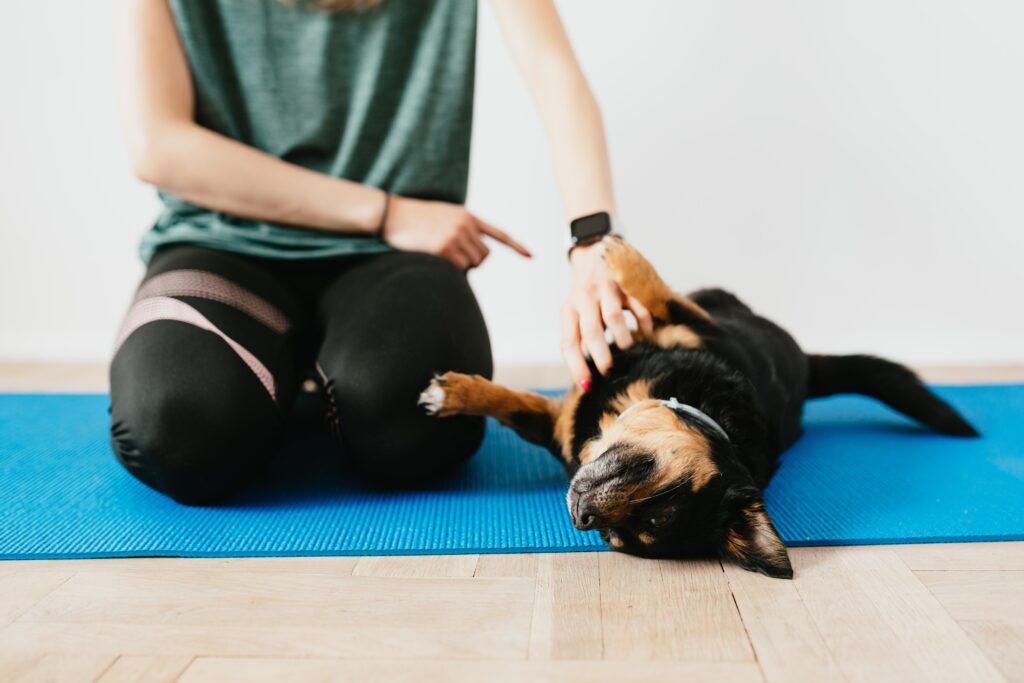Table of Contents
ToggleEnsuring Safety and Comfort for Small Breeds
Introduction
In a world of wagging tails and joyful barks, our furry companions come in all shapes and sizes. Among them, the pint-sized powerhouses are known as small dog breeds. They bring endless delight to our lives. Beneath their tiny frames lies responsibilities of utmost care and attention. That’s where the role of XXS dog harnesses comes to play.
Just like a knight’s armor, a dog harness acts as a protective shield. Larger dogs often rely on their size and strength, while small dog breeds face unique challenges. Their delicate bones and petite frames demand extra caution during walks, outings, and even day-to-day activities. The XXS dog harness serves as their faithful companion, providing unparalleled support, security, and comfort.
These harnesses are specially designed to distribute pressure evenly across a small dog’s body, reducing the risk of injury, strain, or discomfort. In this article, we’ll provide a comprehensive overview of the importance of XXS dog harnesses for small breeds, details the design and functionality of these harnesses, and offers a step-by-step guide for choosing the right harness.

1. Importance of XXS Dog Harnesses for Small Breeds
Small dog breeds possess unique vulnerabilities and require specialized care and equipment to ensure their safety and comfort. In this section, we will delve into the crucial reasons why XXS dog harnesses play a pivotal role in enhancing the well-being of small breeds.
1.1 Understanding the Vulnerabilities of Small Dog Breeds
Small dogs, such as Chihuahuas, Yorkshire Terriers, and Pomeranians, have distinct physical characteristics and needs compared to larger breeds. Their petite size and delicate bone structure make them more susceptible to injuries, strain, and discomfort. It is vital for owners to recognize and address these vulnerabilities.
1.2 Safety Considerations for Small Dogs During Walks
When it comes to walks and outdoor activities, small breeds face different challenges than their larger counterparts. Traditional collars can put excessive pressure on their sensitive necks, potentially causing injury or tracheal damage. An XXS dog harness provides a safer alternative by distributing the force evenly across the dog’s chest and shoulders, reducing strain on delicate neck areas.
1.3 Role of a Properly Fitted Harness in Ensuring Security
A properly fitted XXS dog harness offers a secure and snug fit, preventing small dogs from slipping out or escaping during walks. With adjustable straps and buckles, owners can customize the harness to their dog’s measurements, ensuring a comfortable and secure experience. This level of security promotes peace of mind and allows for worry-free outings.
1.4 Addressing the Risks of Inappropriate Harnesses
Using an ill-fitting or inappropriate harness can lead to discomfort, rubbing, and even injury for small breeds. It is essential to choose an XXS harness specifically designed for its size, taking into account factors such as chest and girth measurements, adjustability, and suitable materials. Investing in a high-quality harness tailored to their needs is paramount.
Understanding the Design and Functionality of XXS Dog Harnesses
Dog harnesses are specifically designed to cater to the unique needs of small breeds. In this section, we will explore the key components, functionality, and various designs available in XXS dog harnesses.
2.1 Key Components of an XXS Dog Harness
An XXS dog harness typically consists of several essential components that work together to provide comfort and security for small breeds. These components may include:
Chest straps: These adjustable straps wrap around the dog’s chest, distributing the force evenly and preventing discomfort.
Back strap: The back strap connects the chest straps and provides stability and support.
D-ring: A sturdy metal ring located on the back of the harness serves as an attachment point for the leash.
Buckles: Adjustable buckles allow for a customized fit and secure fastening of the harness.
Padding: Some XXS harnesses feature padding or soft materials to offer additional comfort for sensitive skin.
2.2 How an XXS Harness Supports a Small Dog’s Body
The design of an XXS dog harness is intended to provide optimal support and minimize strain on a small dog’s body. By distributing the pressure across the chest and shoulders, the harness helps prevent injuries and discomfort, especially in delicate areas like the neck and throat.
2.3 Different Types of XXS Harness Designs Explained
XXS dog harnesses come in various designs, each with its own benefits and features. Common types of harnesses suitable for small breeds include:
Step-in harness: This type of harness allows the dog to step into it, with the straps fastening around the chest and back.
Vest-style harness: A vest-style harness covers a larger area of the dog’s body, providing extra support and security.
Harness dress: This unique design combines a harness with a fashionable dress, offering style and functionality for small female dogs.
Padded harness: Harnesses with extra padding provide additional comfort and reduce the risk of chafing or rubbing.
2.4 Materials Used in XXS Dog Harnesses and Their Benefits
XXS dog harnesses are crafted from a variety of materials, each offering its own advantages. Common materials used include:
Nylon: Nylon is a durable and lightweight material that is easy to clean, making it a popular choice for XXS harnesses.
Mesh: Mesh harnesses are breathable and comfortable, ideal for warmer climates and dogs with sensitive skin.
Neoprene: Neoprene is a soft, flexible material that provides a snug and comfortable fit while being resistant to wear and tear.
Leather: Leather harnesses offer a classic and stylish look while being durable and long-lasting.
Step-by-Step Guide for Choosing the Right XXS Dog Harness
Selecting the right XXS dog harness for your small breed is essential to ensure a comfortable and secure fit. In this section, we will provide a step-by-step guide to help you choose the perfect harness for your furry friend.
3.1 Measuring a Dog for an XXS Harness: A Detailed Process
Accurate measurements are crucial for selecting the appropriate size of an XXS dog harness. Follow these steps to measure your dog:
Measure the chest girth: Use a flexible measuring tape to measure the circumference of your dog’s chest, just behind the front legs. Make sure the tape is snug but not too tight.
Measure the neck girth: Measure the circumference of your dog’s neck at its widest point, typically just above the shoulders.
Measure the length: Measure the distance from the base of the neck to the base of the tail to determine the appropriate length of the harness.
Note: Refer to the specific sizing guidelines provided by the manufacturer of the harness you are considering, as sizes may vary between brands.
3.2 Factors to Consider When Selecting an XXS Harness
When choosing an XXS dog harness, consider the following factors:
Adjustability: Look for a harness with adjustable straps and buckles to ensure a proper fit as your dog grows or if adjustments are needed.
Comfort: Opt for a harness made of soft, breathable materials that won’t irritate your dog’s skin. Consider padded harnesses for extra comfort.
Durability: Choose a harness made from high-quality materials that can withstand your dog’s activity level and last over time.
Ease of Use: Look for harnesses with user-friendly features like quick-release buckles for easy on and off.
Safety Features: Consider harnesses with reflective strips or stitching for improved visibility during low-light conditions.
3.3 Tips for Assessing Quality and Durability of an XXS Harness
To ensure the harness you choose is of good quality and will withstand regular use, consider the following tips:
Check the stitching: Inspect the stitching of the harness to ensure it is strong and secure. Loose or frayed stitching may indicate poor quality.
Examine the hardware: Look for sturdy metal D-rings and buckles that are resistant to rust and corrosion.
Read customer reviews: Research customer reviews and ratings of the harness you are considering to gain insight into its durability and overall performance.
3.4 Common Mistakes to Avoid When Choosing an XXS Harness
- When selecting an XXS dog harness, avoid the following common mistakes:
Choosing the wrong size: Ensure accurate measurements and consult the manufacturer’s sizing guidelines to select the correct size for your dog.
Neglecting adjustability: Select a harness with adjustable straps to achieve a snug and secure fit.
Sacrificing quality for price: Don’t solely base your decision on price; invest in a high-quality harness that will provide long-lasting durability and comfort for your dog.
Training and Introducing an XXS Dog to a Harness
Introducing an XXS dog to a harness requires patience, positive reinforcement, and gradual acclimation. In this section, we will provide a step-by-step guide to help you train your small breed to wear a harness comfortably.
4.1 Preparing Your Small Dog for Harness Training
Before beginning the harness training process, take the following steps to prepare your small dog:
Create a positive environment: Choose a quiet and comfortable area where you can work with your dog without distractions.
Gather treats and rewards: Have a stash of small, tasty treats or favorite toys as positive reinforcement during the training sessions.
Familiarize your dog with the harness: Allow your dog to sniff and explore the harness before attempting to put it on. This helps them become accustomed to its presence.
4.2 Positive Reinforcement Techniques for Introducing the Harness
Use positive reinforcement techniques to create a positive association between your dog and the harness. Follow these steps:
Start with short sessions: Begin by introducing the harness in short sessions, gradually increasing the duration over time.
Associate the harness with rewards: Encourage your dog to approach the harness by offering treats or rewards near it. Repeat this process, gradually moving the treats closer to the harness.
Touch and hold the harness: Once your dog is comfortable approaching the harness, gently touch and hold it against their body while providing praise and rewards.
Gradually progress to putting on the harness: Introduce the concept of wearing the harness by placing it on your dog for brief periods, securing only one or two straps initially.
Reward and praise: Throughout the process, reward your dog with treats, praise, and encouragement to create positive associations with wearing the harness.
4.3 Troubleshooting Challenges During the Training Process
During the training process, you may encounter some challenges. Here are a few common issues and their solutions:
Resistance or fear: If your dog shows resistance or fear, take a step back and go at a slower pace. Offer treats and rewards to create a positive association.
Difficulty with buckles or straps: If your dog becomes agitated or restless when you fasten the buckles or adjust the straps, distract them with treats or toys while securing the harness.
Rubbing or discomfort: If you notice rubbing or discomfort, ensure that the harness is properly adjusted and not too tight. Consider a harness with padding or softer materials to alleviate any discomfort.
4.4 Gradual Progression: Helping Your Dog Adjust to Wearing a Harness
Once your dog becomes comfortable wearing the harness for short periods, gradually increase the duration. Follow these steps:
Extend the wearing time: Gradually increase the duration your dog wears the harness, starting with a few minutes and gradually working up to longer periods.
Practice indoors: Initially, practice indoors where your dog feels safe and comfortable before progressing to outdoor walks.
Associate the harness with positive experiences: Use the harness as a cue for enjoyable activities such as going for walks, playing, or receiving treats, reinforcing the positive association with wearing the harness.
Proper Usage and Safety Guidelines for XXS Dog Harnesses
5.1 Preparing the Harness for Use
Before putting the harness on your dog, follow these steps to ensure it is ready for use:
Adjust the straps: Loosen the straps of the harness to their maximum length before putting it on your dog.
Familiarize with buckles and closures: Identify the buckles, closures, and adjustment points on the harness to ensure you are familiar with its features.
5.2 Step-by-Step Process for Putting on an XXS Dog Harness
Follow these steps to put on the harness on your small breed:
Approach your dog calmly: Approach your dog calmly and gently, reassuring them with a soothing tone of voice.
Slip the harness over the head: Place the harness over your dog’s head, ensuring that the D-ring and leash attachment point are positioned on the back.
Guide the front legs through the harness: Guide your dog’s front legs through the appropriate leg openings of the harness.
Position the harness correctly: Adjust the harness so that it sits comfortably across your dog’s chest, with the back strap resting along their back.
Fasten the buckles: Securely fasten the buckles and closures, ensuring a snug fit without being too tight. Double-check that all buckles are securely closed.
5.3 Adjusting and Securing the XXS Dog Harness
After putting on the harness, follow these steps to ensure a secure and comfortable fit:
Check the tightness: Ensure that the harness is snug but not overly tight. You should be able to fit two fingers between the harness and your dog’s body.
Adjust the straps: If necessary, adjust the straps on the harness to achieve a customized and secure fit. Ensure that the harness does not shift or slide around during movement.
Double-check the security: Confirm that all buckles and closures are securely fastened to prevent the harness from coming undone during walks or activities.
5.4 Performing a Fit Check and Final Adjustments
After securing the harness, perform a fit check and make any necessary final adjustments:
Observe your dog’s movements: Watch your dog as they walk and move around to ensure that the harness does not restrict their movement or cause discomfort.
Check for rubbing or chafing: Examine your dog’s skin for any signs of rubbing or chafing. If you notice any areas of irritation, adjust the harness accordingly or consider switching to a harness with softer padding.
Reassess the fit periodically: As your dog grows or changes shape, periodically reassess the fit of the harness to ensure it remains secure and comfortable.
Maintenance and Care Tips for XXS Dog Harnesses
Proper maintenance and care of an XXS dog harness are essential for ensuring its longevity, functionality, and the comfort of your small breed. In this section, we will provide helpful tips on how to maintain and care for your XXS dog harness.
6.1 Regular Cleaning of the XXS Dog Harness
Regular cleaning is important to keep your dog’s harness clean and hygienic. Follow these guidelines for cleaning an XXS dog harness:
Check the manufacturer’s instructions: Refer to the manufacturer’s guidelines for specific cleaning instructions, as different materials may require different cleaning methods.
Hand wash or machine wash: Depending on the material, you can either hand wash the harness using mild soap and water or machine wash it on a gentle cycle.
Air dry the harness: After washing, allow the harness to air dry thoroughly before using it again. Avoid exposing the harness to direct sunlight or heat sources, as this may damage the material.
6.2 Inspecting and Maintaining the Harness
Regular inspections and maintenance will help identify any issues and ensure the harness remains in good condition. Follow these tips:
Check for wear and tear: Routinely inspect the harness for signs of wear and tear, such as frayed straps, loose stitching, or damaged hardware. Replace the harness if any significant damage is detected.
Tighten loose straps: If you notice any loose straps, tighten them to ensure a secure fit. This will help prevent the harness from shifting or becoming loose during walks.
Lubricate hardware: If the harness has metal hardware, such as buckles or D-rings, apply a small amount of lubricant (such as silicone spray) to ensure smooth operation and prevent rust or corrosion.
6.3 Storing the XXS Dog Harness
Proper storage when the harness is not in use will help maintain its shape and condition. Follow these guidelines:
Clean before storage: Clean the harness thoroughly before storing it to remove any dirt, debris, or odors.
Store in a dry and safe place: Keep the harness in a dry, well-ventilated area away from direct sunlight, moisture, or extreme temperatures.
Avoid sharp objects: Store the harness away from sharp objects or other items that could potentially damage or snag the material.
6.4 Replacing the XXS Dog Harness
Over time, the harness may experience wear and tear or become too small for your growing dog. Consider replacing the harness if you notice any of the following:
Significant damage to straps, stitching, or hardware that compromises the harness’s integrity.
Outgrown size: If your dog has outgrown the XXS size, it’s important to transition to an appropriately sized harness to ensure a proper fit and comfort.
Frequently Asked Questions (FAQs) about XXS Dog Harnesses
Why should I use an XXS harness for my small breed dog?
XXS harnesses are specifically designed for small breeds to ensure their safety and comfort during walks. They distribute pressure evenly and reduce strain on delicate neck areas, providing a safer alternative to traditional collars.
What are the potential risks of using a collar instead of a harness for small dogs?
Traditional collars can put excessive pressure on the sensitive necks of small dogs, potentially causing injuries, tracheal damage, or discomfort. Using an XXS harness helps alleviate these risks.



